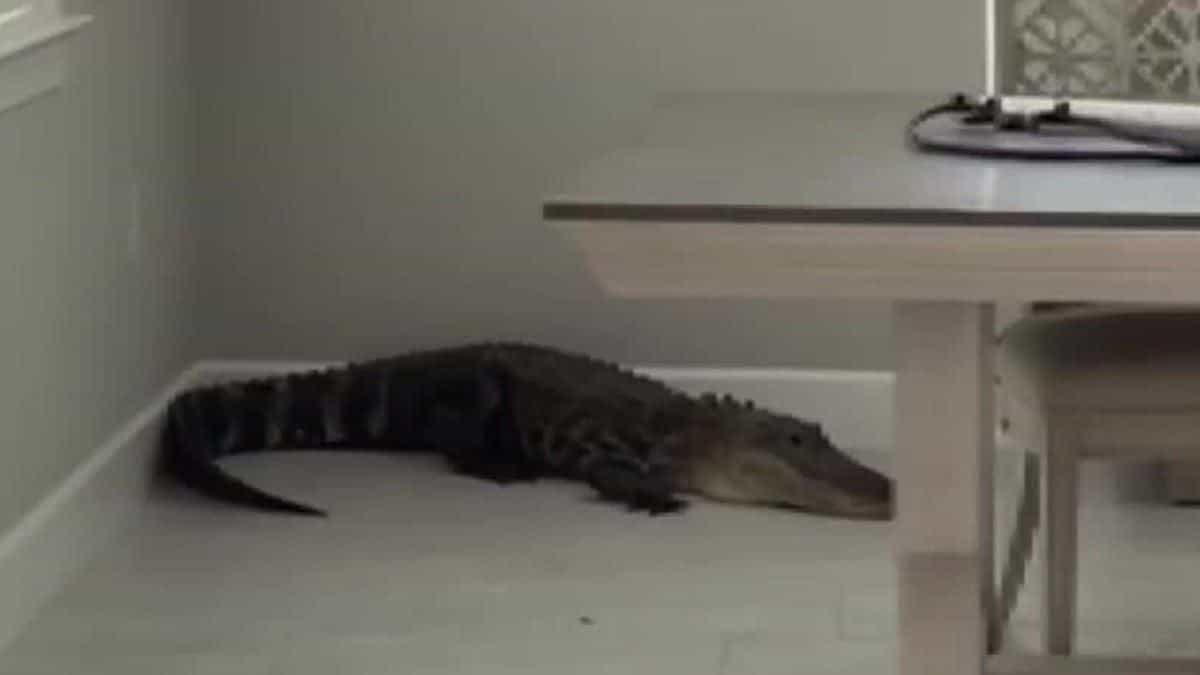Show table of content Hide table of content
Last Sunday in Fort Myers, Florida, a couple faced an unexpected morning guest when they discovered a six-foot alligator had made itself comfortable in their dining room. This real-life encounter resembled scenes from adventure movies where wild animals invade residential spaces, creating both shock and a memorable story for the homeowners.
Unexpected reptilian visitor crashes Florida home
Paul and his wife experienced a startling awakening on March 9, 2025, when they discovered a massive alligator had entered their Fort Myers residence. The couple’s peaceful Sunday morning transformed into a wildlife emergency when Paul noticed something amiss with their home’s entrance.
“I got up and saw the door had a problem with the screen. I wondered what happened. Then I heard something like an air noise, like a hissing sound,” Paul recounted of the bizarre discovery.
News This TikToker buys a used van and realizes it has a hidden surveillance device.
The reptile had torn through the door’s screen mesh before wandering into the dining area, making itself at home among the furniture. Such unexpected wildlife encounters remind us of the surprising interactions between humans and animals that can occur in regions where wildlife and residential areas overlap.
Paul’s initial reaction captured the surreal nature of the situation. “It’s Sunday morning, and I have an alligator in my home?” he remarked, highlighting the absurdity of finding a dangerous predator in his dining room before breakfast.
Wildlife specialist captures dining room predator
Following the shocking discovery, the couple immediately contacted emergency services. A professional trapper from the Florida Fish and Wildlife Conservation Commission responded to the unusual home invasion call. The removal process wasn’t simple, as the powerful reptile showed significant resistance during capture attempts.
The specialist struggled for nearly an hour before successfully restraining the alligator by its neck. During the capture operation, the animal defended itself vigorously, causing damage to several furniture pieces in the process. The dining room chair became a particular casualty of the encounter.
“He had the chair in his mouth and was swinging it around. We’re going to keep it as a conversation piece,” Paul explained, finding humor in the frightening situation. This light-hearted response mirrors how some people develop special bonds with animals, even in unexpected circumstances.
After the successful capture, authorities transported the alligator to northern Florida, where it was safely released back into its natural habitat, far from residential areas. This incident serves as a reminder of the importance of maintaining appropriate boundaries with wildlife, especially in regions like Florida where human development frequently intersects with animal territories.
Florida’s ongoing human-alligator coexistence challenges
While this incident might seem extraordinary, Florida residents face the reality of sharing their state with approximately 1.3 million alligators, according to the Florida Fish and Wildlife Conservation Commission. These prehistoric reptiles inhabit many of the state’s waterways, creating inevitable interaction points with human populations.
Fort Myers, located in southwestern Florida, features numerous waterways that provide ideal habitats for these reptiles. During warm spring months, alligators become increasingly active as they search for food and mates, sometimes wandering into residential areas. This behavior explains why incidents like Paul’s dining room encounter typically increase during certain seasons.
News Bat wings after 50? Here’s the most effective exercise, according to a coach.
The unique wildlife presence is part of what makes Florida distinctive among American states. While tourists often flock to commercialized areas like Miami, experiencing the real Florida means understanding its wild side, including the presence of native species like alligators.
Florida’s wildlife management programs focus on educating residents about safely coexisting with these prehistoric predators. Unlike some communities that have chosen to ban modern technologies for specific reasons, Florida embraces modern wildlife management techniques while respecting the state’s natural inhabitants.
Wildlife safety precautions for Florida residents
Incidents like the Fort Myers dining room invasion highlight the importance of taking preventative measures, especially in areas known for alligator populations. Wildlife experts recommend several precautions for those living in or visiting alligator-prone regions.
Securing entryways with sturdy materials rather than simple screens can prevent determined reptiles from gaining access. Additionally, avoiding outdoor activities near waterways during dawn and dusk, when alligators are most active, reduces encounter risks. These safety measures are particularly important when traveling with pets in wildlife-rich areas.
Wildlife authorities emphasize the importance of never feeding alligators, as this creates dangerous associations between humans and food. Some communities have established special response teams trained specifically for wildlife intrusions, similar to how some organizations have developed unique relationships with animals, such as the remarkable case of a crow that repaid human kindness in an unexpected way.
For tourists exploring Florida beyond its beaches and theme parks, understanding wildlife safety becomes an essential part of trip planning. Whether visiting Fort Myers or exploring other destinations like New Orleans, being informed about local wildlife adds a layer of safety to any travel experience.
As Paul and his wife learned that Sunday morning, Florida’s wildlife sometimes makes unexpected house calls. Their story serves as both a cautionary tale and a reminder of the wild side of the Sunshine State that residents have learned to respect and accommodate, sometimes with a sense of humor and a damaged dining chair as a lasting memento.


